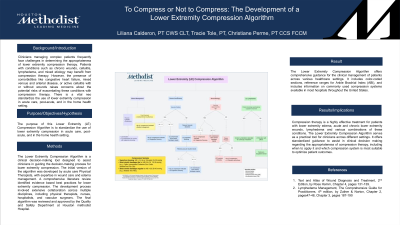Practice Innovations
(PI-006) To Compress or Not to Compress: The Development of a Lower Extremity Compression Algorithm
Friday, May 2, 2025
7:45 PM - 8:45 PM East Coast USA Time

Tracie Cross, PT – Sr Physical Therapist, Rehabilitation Services, Houston Methodist Hospital; Christiane Perme, PT, CCS, FCCM – Rehab Education Specialist, Rehabilitation Services, Houston Methodist Hospital
Introduction: Clinicians managing complex patients frequently face challenges in determining the appropriateness of lower extremity compression therapy. Patients with conditions such as chronic wounds, cellulitis, lymphedema, and mixed etiology may benefit from compression therapy. However, the presence of comorbidities like congestive heart failure, mixed venous and arterial disease, or active cellulitis with or without wounds raises concerns about the potential risks of exacerbating these conditions with compression therapy. There is a vital need to standardize the use of lower extremity compression in acute care, post acute, and in the home health setting.
Methods: The Lower Extremity Compression Algorithm is a clinical decision-making tool designed to assist clinicians in guiding the decision-making process for lower extremity compression. The initial version of the algorithm was developed by acute care Physical Therapists, with expertise in wound care and edema management. A comprehensive literature review identified evidence based best practices for lower extremity compression. The development process involved extensive collaboration across multiple disciplines, including physical therapists, nurses, hospitalists, and vascular surgeons. The final algorithm was reviewed and approved by the hospital's Quality and Safety Department.
Results: The Lower Extremity Compression Algorithm offers comprehensive guidance for the clinical management of patients across various healthcare settings. It includes color-coded sections, reference ranges for Ankle Brachial Index (ABI), and includes information on commonly used compression systems available in most hospitals throughout the United States.
Discussion: Compression therapy is a highly effective treatment for patients with lower extremity edema, acute and chronic lower extremity wounds, lymphedema and various combinations of these conditions. The Lower Extremity Compression Algorithm serves as a practical tool for clinicians across different settings. It offers standardized guidance to assist in clinical decision making regarding the appropriateness of compression therapy, including when to apply it and which compression system is most suitable to optimize patient outcomes.
Methods: The Lower Extremity Compression Algorithm is a clinical decision-making tool designed to assist clinicians in guiding the decision-making process for lower extremity compression. The initial version of the algorithm was developed by acute care Physical Therapists, with expertise in wound care and edema management. A comprehensive literature review identified evidence based best practices for lower extremity compression. The development process involved extensive collaboration across multiple disciplines, including physical therapists, nurses, hospitalists, and vascular surgeons. The final algorithm was reviewed and approved by the hospital's Quality and Safety Department.
Results: The Lower Extremity Compression Algorithm offers comprehensive guidance for the clinical management of patients across various healthcare settings. It includes color-coded sections, reference ranges for Ankle Brachial Index (ABI), and includes information on commonly used compression systems available in most hospitals throughout the United States.
Discussion: Compression therapy is a highly effective treatment for patients with lower extremity edema, acute and chronic lower extremity wounds, lymphedema and various combinations of these conditions. The Lower Extremity Compression Algorithm serves as a practical tool for clinicians across different settings. It offers standardized guidance to assist in clinical decision making regarding the appropriateness of compression therapy, including when to apply it and which compression system is most suitable to optimize patient outcomes.

.jpg)